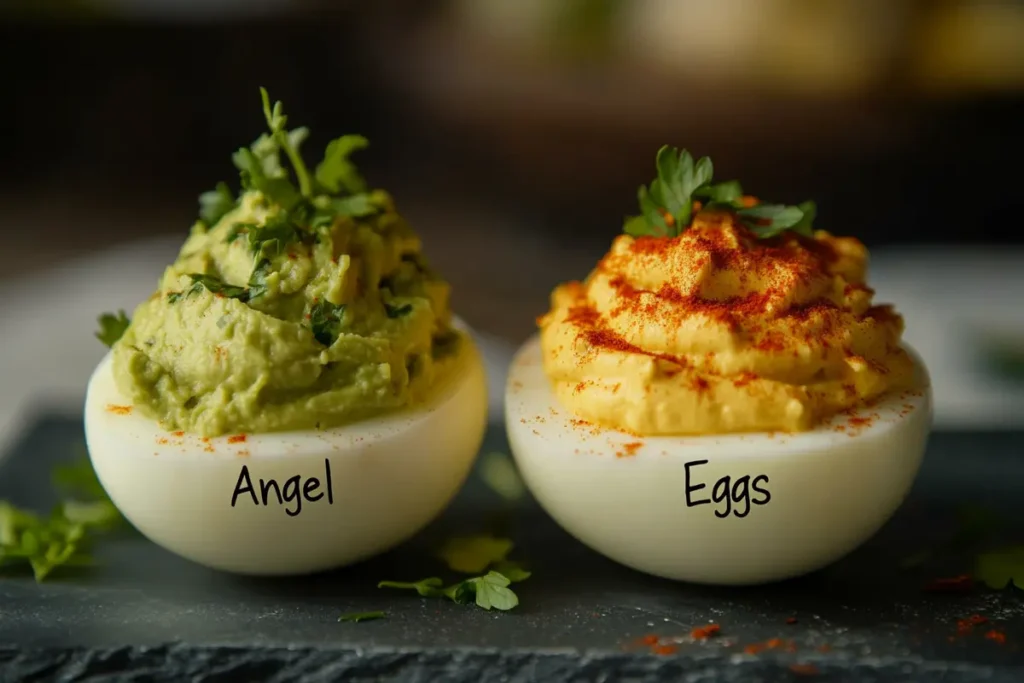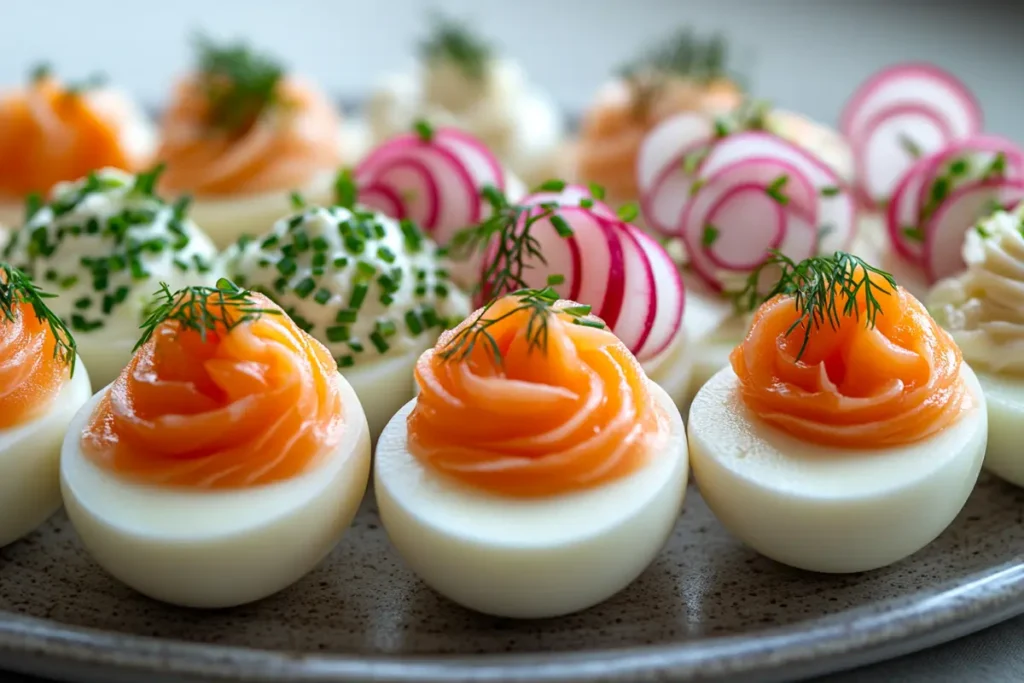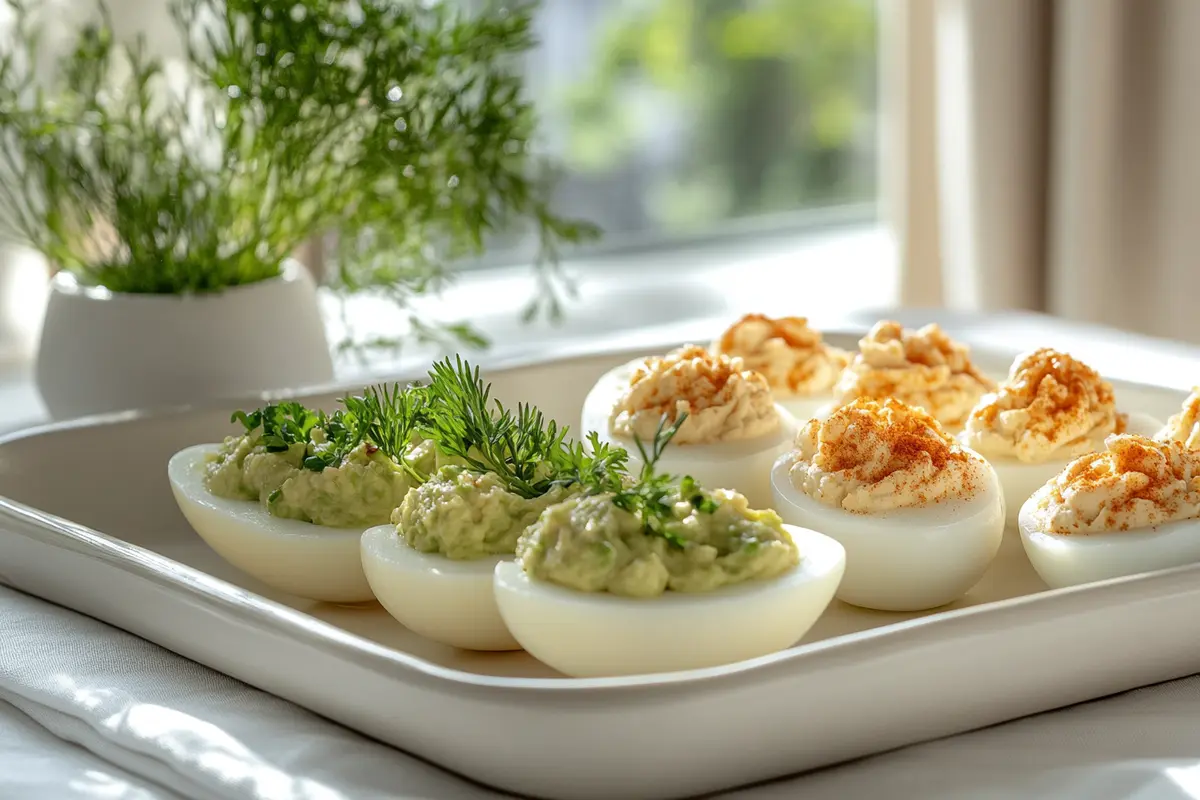Eggs are among the most versatile and beloved ingredients in cooking, and two dishes that highlight their potential are angel eggs and deviled eggs. At first glance, these recipes may seem similar, but they differ significantly in taste, ingredients, and preparation.
Deviled eggs, a classic favorite, are renowned for their rich and tangy filling, while angel eggs offer a lighter, healthier twist. Both options are excellent for gatherings, whether it’s a party, picnic, or family meal, making your choice a matter of preference and dietary goals.
In this article, we’ll dive deep into the difference between angel eggs and deviled eggs, exploring their history, ingredients, and preparation methods. By the end, you’ll have all the details to decide which dish to serve at your next event. Let’s get started!
Table of Contents
What Are Deviled Eggs?
Deviled eggs are a classic appetizer loved for their creamy, tangy, and slightly spicy flavor. This dish consists of hard-boiled eggs that are sliced in half, with their yolks removed and mixed into a flavorful filling. The filling is then piped or spooned back into the hollowed egg whites, creating a visually appealing and tasty treat.
Origin of Deviled Eggs
The difference between angel eggs and deviled eggs becomes clearer when we explore their origins. The term “deviled” might sound dramatic, but it has been used in cooking since the 18th century to describe dishes with bold, spicy flavors, often including mustard or hot ingredients.
The origin of deviled eggs can be traced back to ancient Rome, where eggs were boiled, seasoned, and served as appetizers during feasts. This practice eventually evolved into the deviled eggs we know today. Their rich and tangy filling sets them apart from the lighter, healthier angel eggs.
In the United States, deviled eggs became a staple at potlucks, picnics, and family gatherings by the mid-20th century. The creamy textures and bold flavors of deviled eggs highlight the differences between deviled eggs and angel eggs, which often cater to different taste preferences and dietary choices.
Typical Ingredients in Deviled Eggs
The ingredients in traditional deviled eggs are simple yet flavorful. Here’s what you’ll typically find:
- Eggs: Hard-boiled eggs are, of course, the main component.
- Mayonnaise: This adds creaminess to the filling.
- Mustard: A tangy kick, often in the form of Dijon or yellow mustard.
- Vinegar: A splash of vinegar or pickle juice gives the filling a slight tang.
- Paprika: A sprinkle of paprika on top not only adds flavor but also enhances the presentation.
- Salt and Pepper: These seasonings bring out the flavors of the other ingredients.
Some variations also include extras like chopped chives, bacon bits, or hot sauce for added flair.
How Deviled Eggs Are Made
Making deviled eggs is straightforward and doesn’t require a lot of time. Here’s a step-by-step guide to preparing them:
- Hard-Boil the Eggs: Place the eggs in a pot of water, bring it to a boil, and let them cook for about 10–12 minutes. Once done, transfer the eggs to an ice bath to cool.
- Peel the Eggs: Carefully peel the shells off the eggs without damaging the whites.
- Slice and Scoop: Slice the eggs in half lengthwise and gently scoop out the yolks.
- Prepare the Filling: Mash the yolks in a bowl and mix them with mayonnaise, mustard, vinegar, salt, and pepper until smooth.
- Fill the Egg Whites: Spoon or pipe the yolk mixture back into the egg white halves.
- Garnish and Serve: Sprinkle paprika and any additional toppings over the eggs before serving.
The result is a dish that’s creamy, tangy, and always a crowd-pleaser. Deviled eggs are versatile and can be customized to suit different tastes, which is part of their lasting appeal.
What Are Angel Eggs?
Angel eggs are a fresh and creative twist on the classic deviled eggs recipe. They are designed to be lighter and healthier, often using alternative ingredients to create a filling that is lower in fat and calories. While deviled eggs rely on mayonnaise and other rich ingredients, angel eggs focus on wholesome options like Greek yogurt, avocado, or even hummus.
Angel eggs have gained popularity in recent years as people look for healthier ways to enjoy their favorite dishes. They are just as versatile and delicious as deviled eggs but appeal more to those seeking nutritious snacks or appetizers.
The Meaning Behind Angel Eggs
The difference between angel eggs and deviled eggs starts with their names. While the term “deviled” is associated with bold, spicy, or indulgent foods, “angel eggs” conveys a sense of something lighter, milder, and more wholesome. This distinction reflects the healthier approach typically used in preparing angel eggs.
For some, choosing the term “angel eggs” over “deviled eggs” also stems from personal or cultural reasons, as it avoids the negative connotations tied to the word “deviled.” This difference in naming not only highlights their contrasting characteristics but also adds a unique touch to the dish.
By understanding the difference between deviled eggs and angel eggs, it’s easy to appreciate how the lighter, wholesome nature of angel eggs makes them a delightful alternative for those seeking a healthier option.
Ingredients in Angel Eggs
The ingredients in angel eggs often differ from the traditional deviled egg recipe. Here are some common ingredients you might find in angel eggs:
- Eggs: Just like deviled eggs, angel eggs start with hard-boiled eggs.
- Greek Yogurt: This is often used as a substitute for mayonnaise. It’s creamy but much lower in fat.
- Avocado: Some recipes use mashed avocado for its smooth texture and healthy fats.
- Hummus: For a Mediterranean twist, hummus can be added to the filling.
- Fresh Herbs: Ingredients like dill, parsley, or chives add freshness and flavor.
- Lemon Juice: A squeeze of lemon brightens the filling and enhances the flavor.
- Salt and Pepper: Simple seasonings that bring everything together.
Other optional ingredients include garlic powder, smoked paprika, or diced vegetables for added crunch.
How Angel Eggs Are Prepared
Making angel eggs is similar to preparing deviled eggs, but the filling is where the differences shine. Here’s a simple guide:
- Hard-Boil the Eggs: Start by boiling the eggs for 10–12 minutes, then place them in an ice bath to cool.
- Peel and Slice: Carefully peel the eggs and slice them in half lengthwise.
- Remove the Yolks: Scoop out the yolks and place them in a bowl.
- Mix the Filling: Mash the yolks and mix them with Greek yogurt, avocado, or hummus. Add lemon juice, salt, pepper, and fresh herbs.
- Fill the Egg Whites: Spoon or pipe the filling back into the egg white halves.
- Garnish and Serve: Garnish with herbs, a sprinkle of paprika, or even a slice of radish for a fresh touch.
The result is a dish that feels light, refreshing, and just as satisfying as deviled eggs. Angel eggs are perfect for anyone looking for a healthier alternative to the traditional recipe.
Key Differences Between Angel Eggs and Deviled Eggs

At first glance, angel eggs and deviled eggs look similar, but they have clear differences. These differences come down to their ingredients, flavor, and how healthy they are. Let’s take a closer look!
Health and Nutrition Differences
One of the biggest differences between angel eggs and deviled eggs is their nutritional value:
- Deviled Eggs: These are higher in calories and fat because they use mayonnaise. They are rich and creamy, which makes them delicious but less healthy.
- Angel Eggs: These are lighter because they use healthier ingredients like Greek yogurt or avocado. They have fewer calories and contain more good fats, making them a better choice for health-conscious eaters.
Taste and Texture
The taste and texture of these two dishes are also different:
- Deviled Eggs: These have a bold and tangy flavor, often with a spicy kick from mustard or paprika. The filling is smooth and rich.
- Angel Eggs: These taste fresh and mild, with a lighter filling. The texture can vary depending on whether you use avocado, yogurt, or hummus.
When to Serve Them
Both angel and deviled eggs are great appetizers, but they are suited to different occasions:
- Deviled Eggs: Perfect for parties, holidays, and classic gatherings. Their rich flavor makes them a crowd-pleaser.
- Angel Eggs: Great for health-focused events, picnics, or brunch. They’re ideal for people who want a lighter, fresher option.
Quick Comparison
| Feature | Deviled Eggs | Angel Eggs |
|---|---|---|
| Calories | Higher | Lower |
| Main Ingredient | Mayonnaise | Greek yogurt, avocado, etc. |
| Flavor | Bold and creamy | Light and refreshing |
| Best For | Parties and holidays | Healthy meals and picnics |
As you can see, both recipes are delicious but cater to different preferences and needs. Whether you choose deviled eggs or angel eggs depends on your taste and the occasion!
Common Misconceptions About Angel Eggs and Deviled Eggs
Even though angel eggs and deviled eggs are similar in appearance, some common misunderstandings can make it confusing to tell them apart. Let’s clear up a few of these misconceptions.
1. Are Angel Eggs the Same as Vegan Deviled Eggs?
No, angel eggs are not the same as vegan deviled eggs. Angel eggs still use hard-boiled eggs as the base, which means they are not vegan. However, you can create a vegan version of deviled or angel eggs by replacing the eggs with plant-based ingredients like tofu or chickpeas. This gives you the same look and feel without using animal products.
2. Do Angel Eggs Always Avoid Mayonnaise?
Not always. While most angel egg recipes avoid mayonnaise and use healthier substitutes like Greek yogurt or avocado, it’s not a strict rule. Some people still add a small amount of mayo for creaminess, depending on their preferences. Angel eggs are more about using lighter, wholesome ingredients, so they are flexible.
3. Are Angel Eggs Always Healthier?
In general, angel eggs are considered healthier because they use lighter ingredients. For example, swapping mayo for yogurt or avocado reduces calories and adds healthy nutrients. But the final dish depends on what you add. If you use salty or high-fat ingredients, angel eggs may not always be a low-calorie option.
4. Are Deviled Eggs Always Spicy?
Not necessarily. The term “deviled” originally meant bold or spicy flavors, but many modern deviled egg recipes are mild. Some people add mustard or hot sauce for a kick, but others prefer a tangy, creamy flavor without spice. The spiciness depends on the ingredients you choose.
5. Are Angel Eggs and Deviled Eggs the Same Recipe?
No, they are not the same. While both dishes start with hard-boiled eggs, the fillings are different. Deviled eggs use mayo, mustard, and seasonings for a rich, tangy flavor. Angel eggs focus on lighter options like yogurt, avocado, or hummus. This makes them a healthier alternative.
6. Why Are They Called Angel and Deviled Eggs?
The names are symbolic. “Deviled” is a term used for foods that are rich, bold, or spicy, which describes deviled eggs perfectly. “Angel,” on the other hand, suggests something lighter, healthier, or more wholesome, which is the idea behind angel eggs.
By clearing up these misconceptions, you can now better understand what makes angel eggs and deviled eggs unique. Each dish has its own style and flavor, so you can choose the one that fits your taste or event!
How to Customize Your Egg Recipe

Both angel eggs and deviled eggs are incredibly versatile. You can easily customize them with different ingredients, flavors, and presentations to make them unique. Here’s how:
Creative Ingredients
Add new flavors to your eggs by trying ingredients like:
- Deviled Eggs: Bacon crumbles, hot sauce, pickles, or smoked salmon.
- Angel Eggs: Avocado, hummus, fresh herbs, or lemon zest.
These additions can completely transform the taste while keeping the dish exciting.
Presentation Tips
Make your eggs look more appealing by using these simple tricks:
- Pipe the filling neatly with a bag for a polished look.
- Garnish with paprika, fresh herbs, or small veggie slices like radishes.
Adapting to Dietary Needs
Both recipes can be adjusted for specific diets:
- Low-Carb: Naturally perfect for keto diets.
- Dairy-Free: Use avocado or hummus instead of yogurt or mayo.
- Vegan: Replace eggs with tofu or chickpeas for a plant-based version.
With a few small changes, you can make angel eggs or deviled eggs that perfectly suit your taste and the occasion!
FAQs
1. What makes angel eggs healthier than deviled eggs?
Angel eggs are healthier because they use lighter ingredients such as Greek yogurt, avocado, or hummus instead of mayonnaise. These substitutes not only reduce calories but also provide healthy fats. For inspiration, explore this popular Deviled Egg Recipe Without Mayo.
2. Can I make angel eggs without eggs?
Yes, you can! A vegan version of angel eggs can be made by using plant-based alternatives like tofu or chickpeas to mimic the texture of eggs and yolk filling. For more ideas, check out the delicious Avocado Chicken Salad for a healthy and satisfying option.
3. Are deviled eggs always spicy?
No, deviled eggs don’t have to be spicy. While some recipes incorporate mustard, paprika, or hot sauce, there are plenty of milder versions that focus on tangy or creamy flavors instead. If you enjoy subtle flavors, pair them with Easy Zucchini Carrot Fritters for a well-rounded appetizer spread.
Conclusion
The difference between angel eggs and deviled eggs goes beyond their appearance. While deviled eggs are rich, creamy, and perfect for those who enjoy classic indulgence, angel eggs cater to those seeking a lighter, healthier alternative. Both dishes are easy to prepare, incredibly versatile, and loved by people of all ages.
Why not explore the difference between deviled eggs and angel eggs by trying both recipes at your next gathering? Whether you’re hosting a party or enjoying a family meal, these egg-based dishes offer something delicious for everyone.

